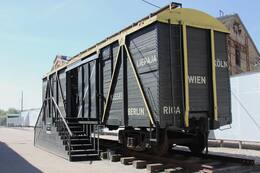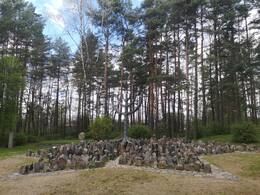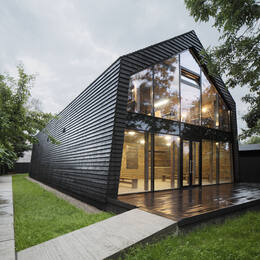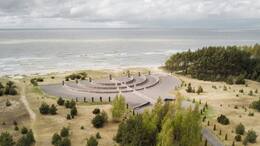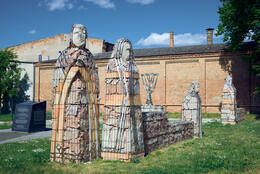Rygos getas ir holokaustas
Sąmoningai parinkti trijų skirtingų žmonių atsiminimų fragmentai, leidžiantys tiksliau pažvelgti į Holokausto nusikaltimą iš skirtingų požiūrių.
Vokiečių armijos generolas majoras WALTERIS BRUNSAS stebėjo Rumbulos veiksmą: „Duobės buvo 24 m ilgio ir apie 3 m pločio, jos turėjo gulėti kaip sardinės skardinėje, galvomis į vidurį. Viršuje šeši su kulkosvaidžiais, kurie tada šaudė į galvą. Kai atėjau, jau buvo pilna, gyvieji turėjo gulėti ant viršaus, o tada reikėjo gelbėti; eilės [...] Priėję arčiau pamatė, kas atsitiko prieš juos [...] Turėjo grąžinti savo papuošalus ir lagaminus, o likusieji - nusirengti 500m iki miško.
ŽANIS LIPKE, žydų gelbėtojas: "Buvau mažame būrelyje žmonių, kurie išsigandę stovėjo už geto tvoros ir stebėjo, kas vyksta už spygliuotos vielos. Buvo tikras chaosas: žmonės bejėgiškai veržėsi iš vienos vietos į kitą, šaukė, verkė. Vieni tampė vienus ryšulius ir nešė lagaminus ar stūmė į policininkus, kiti vaikai. nebalsī bļāva uz cilvēkiem, rāva tos ārā no dzīvokļiem un nežēlīgi sit.. Daži šucmaņi, kur pagadās – pašā pūlī [...] līķu Māja atradās Lāčplēša gatvėje prie spygliuotos tvoros, kuri juosė getą"
Rygos geto kalinys BEILA HAMBURGAS išgyveno Rumbulos akciją: „Žmonės pamažu judėjo pirmyn, policininkai skambino „greičiau, greičiau“, bet niekas nepadėjo. Tapome abejingi, dingo noras gyventi. Ėjome Moskavos gatve, žmonės stovėjo prie langų ir spoksojo į mus. Kai kurie šluostė akis, bet vienas net pamačiau, kad fabrikas pasitrynė. „Kvadratas“, esantis prie miesto ribos, ir tęsėsi tol, kol išgirdome daug šūvių. Dabar vaikai jau buvo girti ir tik ragino „greičiau, greičiau“.
Generolas majoras Walteris Brunsas (1891 – 1957) – vokiečių armijos inžinierius – pulkininkas, 1941 m. pabaigoje dislokuotas netoli Rygos, tapęs masinių žudynių Rumbuloje liudininku. Jis buvo sugautas 1945 m. balandžio 8 d. ir laikomas kaliniu britų vokiečių karininkų sulaikymo stovykloje. Šiose areštinėse buvo įrengti pasiklausymo įrenginiai, todėl kalinių pokalbiai buvo fiksuojami ir įrašinėjami. Viename iš tokių pokalbių tarp Brunso ir kitų pareigūnų jis kalbėjo apie įvykius Rumbuloje, pateikdamas Holokausto Rygoje įrodymus. 1948 m. Brunsas davė parodymus kaip liudininkas teisme prieš Vermachto vyriausiąją vadovybę. Tais pačiais metais jis buvo paleistas iš kalėjimo.
Žanis Lipke (1900 – 1987) buvo Rygos uosto dokininkas. Kai naciai užėmė Rygą, jis norėjo padėti žydų bendruomenei. Tam jis įsidarbino Luftwaffe sandėliuose prie Centrinio turgaus prie Rygos geto. Jis turėjo vesti žydus į sandėlius ir iš jų. Lipkė pasinaudojo šia galimybe paslėpti dalį žydų, kad jiems nereikėtų grįžti į getą, o vykti į Lipkės namus, kur jau buvo jiems paruošęs bunkerį. Vėliau Žanis Lipke pas pažįstamus Rygoje ir Dobelėje rado kitas vietas žydams slėpti. Iš viso Žanis Lipkė su padėjėjais išgelbėjo daugiau nei 50 žmonių.
Beila Hamburgas buvo Rygos geto kalinys, išgyvenęs Rumbulos kampaniją. Mirė Štuthofo koncentracijos stovykloje
Prisiminimai skelbiami Latvijos okupacijos muziejaus svetainėje. Prieiga: http://okupacijasmuzejs.lv/rumbula/
Susijusi laiko juosta
Susijusios temos
Susijusios vietos
Riga Ghetto and Latvian Holocaust Museum
The Riga Ghetto and the Latvian Holocaust Museum is located in Riga close to the Riga Central Market and the Riga Central Station. The museum was opened in 2010 on the site where the city's warehouses once were. It is located in the historical part of the city, next to the border of the former Jewish ghetto. The territory of the ghetto is unique, because in terms of architecture it has not changed since World War II. It is a memorial dedicated to the tragedy suffered by the Jewish people. The German policy regarding the Jewish population in Latvia until the end of 1939 was for the German diplomats and politicians to try and pressure the Latvian government to take action against the Jews by restricting their freedom. After the emigration of the Baltic Germans in 1939, the German embassy no longer had as good an access to information on the mood of the population and the events happening in Latvia as before. When the Red Army occupied Latvia, they manipulated the society to gain some support of the Jewish population for the new occupying power. However, after the regime started a crackdown on the society as a whole, the support fell rapidly. As a result of all this, a deep divide had formed between the people. And later on, the next regime – Germany – tried to exploit it. They hoped that the local population would harass and attack the Jews, but that did not happen. So, Germany adjusted their approach and devised a new plan to initially establish a Jewish ghetto and later destroy its inhabitants.
Jewish Memorial at Rumbula
Located in Rumbula, near Moskava Street.
Rumbula is one of the largest sites of mass extermination of Jews in Europe. During two actions - 1941. On November 30 and December 8, which were realized based on the Nazi leadership's decision to completely exterminate the Jews imprisoned in the Riga ghetto, more than 25,000 people were shot in the Rumbula forest, including approximately 1,000 Jews deported from Germany. 1944 Several hundred Jewish men from the Kaiserwald concentration camp were also killed in Rumbula.
The first attempts to perpetuate the memory of the Jews killed in Rumbula date back to the end of the 60s. Despite the restrictions of the Soviet government, as a result of the initiative of some Jews in 1963. a wooden commemorative plaque with an inscription in Yiddish was attached to one of Rumbula's pine trees, while a large poster of the artist Josif Kuzkovskis "The Jew" was installed near the Rumbula railway (near the Riga-Moscow line). The poster showed the image of a man rising from the grave with a clenched fist, symbolizing a protest against what had been done. Both the commemorative plaque and the poster already in 1964. were harvested, but the Jews managed to obtain permission to erect a memorial stone in Rumbula with the inscription "Victims of Fascism" not only in Latvian and Russian, but also in Yiddish.
in 2002 On November 29, the memorial ensemble was opened in Rumbula according to the project of architect Sergejs Riž. Its establishment was financially supported by the institutions of Latvia, Israel, the USA and Germany, as well as private individuals.
On the side of the highway, by the road that leads to the memorial, a metal structure symbolizing the forces of Nazism has been installed as a sign. Nearby is a stone with the explanation that thousands of Jews were chased to death along this road. At the entrance to the memorial itself, several stone plaques with inscriptions in Latvian, English, German and Hebrew introduce the events of the Rumbula tragedy and the history of the establishment of the memorial. In the central part of the memorial, above the square, which is made in the shape of the Star of David, rises a seven-branched candlestick - a menorah, surrounded by stones with engraved names of the Jews killed in Rumbula. The names of the streets of the former Riga ghetto are engraved in individual stones with which the square is paved. There are several mass graves on the territory of the memorial, the places of which are marked with rectangular concrete borders.
Žanis Lipke Memorial
The Žanis Lipke memorial is located in Ķīpsala, Riga. The Žanis Lipke Museum is probably one of the most hidden museums in Riga. The obscure location of the memorial is not a coincidence and it has a symbolic meaning. It has been set up in the location of a former underground hideout that was created to save people during the German occupation of World War II. Here Žanis Lipke and his family rescued 55 Jews. Nowadays a memorial has been built next to the Žanis Lipke family house. The memorial ‘Black Shed’ is a symbolic building where shelter was provided and received. The design of the building has been taken from the historical tarred huts of Ķīpsala fishermen and sailors. These huts were built using materials from barges; hence they had a very distinct colour and tar smell. But not only the story of this historic place is unique. The way the museum communicates its message is also quite notable. The overall design has similarities with the Noah’s Ark described in the Bible, and it also resembles a boat that has been pulled ashore and overturned – a boat that has fulfilled its task. The concept of this memorial draws from the historic accuracy of this place and story and the testimonies associated with it. It is a story of a desire for freedom, unbelievable escape and trust. On your way to the museum, you’ll also be able to see the historic buildings of Pārdaugava.
Memorial to the victims of holocaust in Liepāja
The largest memorial to Holocaust victims in Latvia is located in Liepāja, in the Šķēde dunes. The memorial is dedicated to the memory of more than 3,000 Liepāja Jews killed during World War II. It is in the form of the Israeli national symbol, a seven-branched candelabra known as the menorah. The contours of the memorial, which are clearly visible from a bird’s eye view, are made of split boulders and granite blocks. The ‘lights’ of the menorah are made of granite pillars with inscriptions of verses from the Lamentations of Jeremiah in Hebrew, English, Latvian and Russian.
Atminimo memorialas „Sinagogos sodas“ (Sinagogas dārzs)
Memorialas yra miesto centre, netoli Bauskės savivaldybės Turizmo informacijos centro ir Rotušės aikštės. Jis sukurtas Bauskės žydų palikuonių Izraelyje, JAV ir Di džiojoje Britanijoje iniciatyva ir aukomis, taip pat Bauskės savivaldybės tarybos ir Latvijos žydų bendruomenių bei bendrijų paramos dėka. Memorialą suprojektavo skulptorius Girtis Burvis. Jis yra buvusios Bauskės Didžiosios sinagogos dydžio, o akmens statulos simbolizuoja žydus, išeinančius iš sinagogos po pamaldų. Memorialo centre stovi simbolinė bima – pa aukštinta platforma arba stalas, naudojamas sinagogoje per žydų religines apeigas. Ant jos parašyta: „Pagarba Bauskės žydams, kurie čia gyveno šimtmečius ir kūrė šį miestą, o 1941 m. buvo nužudyti nacių ir jų vietinių parankinių. Pagerbiant žydų tautos atminimą – Bauskės žydų palikuonys ir Bauskės gyventojai.“ 1935 m. Bauskėje gyveno beveik 800 žydų. 1941 m. liepą, prasidėjus nacių okupacijai, daug žydų buvo suimti ir iš vežti, o apie 700 žydų sušaudyti. Bauskės Didžioji sinagoga buvo sugriauta per Antrąjį pasaulinį karą.





